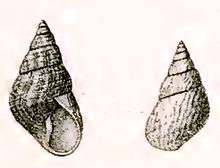Phasianotrochus irisodontes
| Phasianotrochus irisodontes | |
|---|---|
 | |
| Drawing with two views of a shell of Phasianotrochus irisodontes | |
| Scientific classification | |
| Kingdom: | Animalia |
| Phylum: | Mollusca |
| Class: | Gastropoda |
| Clade: | Vetigastropoda |
| Superfamily: | Trochoidea |
| Family: | Trochidae |
| Genus: | Phasianotrochus |
| Species: | P. irisodontes |
| Binomial name | |
| Phasianotrochus irisodontes (Quoy & Gaimard, 1834) [1] | |
| Synonyms[2] | |
| |
Phasianotrochus irisodontes, common name the rainbow kelp or the green necklace shell, is a species of sea snail, a marine gastropod mollusk in the family Trochidae, the top snails.[2][3]
Description
The height of the shell varies between 10 mm and 20 mm. The pointed, imperforate, solid shell has an elongated conic shape. It is polished, yellowish, pink, or olive-green, with reddish or olive longitudinal lines in pairs, sometimes separate on the body whorl, and usually with numerous narrow, rather obscure spiral pink or yellowish lines. It sometimes has a few series of white dots on the upper part. The conic spire is shorter and less attenuated than in Phasianotrochus bellulus. The about 7 whorls are scarcely convex. The body whorl is not carinate. It is finely striate beneath,and smooth above. The aperture is rather large, often expanded. It is smooth inside, lined with intensely green nacre. The columella is strongly toothed below.
The coloration is quite variable with even unicolored green specimens. The aperture is sometimes so dilated that the spire seems to lean to that side. [4]
Distribution
This marine species is endemic to Australia and occurs in the subtidal and the lower intertidal zone off South Australia, Tasmania, Victoria and Western Australia.
References
- ↑ Quoy, J.R. & Gaimard, J.P. 1834. Voyage de Découvertes de l'Astrolabe exécuté par Ordre du Roi, Pendant les Années 1826-1829. Paris : J. Tastu Zoologie Vol. 3 366 pp
- 1 2 Bouchet, P. (2012). Phasianotrochus irisodontes (Quoy & Gaimard, 1834). Accessed through: World Register of Marine Species at http://www.marinespecies.org/aphia.php?p=taxdetails&id=573221 on 2012-11-23
- ↑ Hickman C.S. (2005) Seagrass fauna of the temperate southern coast of Australia I: The cantharidine trochid gastropods. In: F.E. Wells, D.I. Walker & G.A. Kendrick (eds), The marine flora and fauna of Esperance, Western Australia: 199-220. Western Australian Museum, Perth.
- ↑ Tryon (1889), Manual of Conchology XI, Academy of Natural Sciences, Philadelphia
- Menke, C.T. 1843. Molluscorum Novae Hollandiae Specimen in Libraria Aulica Hahniana. Hannover : Hahniana 46 pp.
- Philippi, R.A. 1845. Abbildungen und Beschriebungen neuer oder wenig gekannter Conchylien. Cassel : Theodor Fischer Vol. 2 64 pp.
- Philippi, R.A. 1850. Trochidae. pp. 121-136 in Küster, H.C. (ed). Systematisches Conchylien-Cabinet von Martini und Chemnitz. Nürnberg : Bauer & Raspe Vol. II.
- Adams, A. 1853. Contributions towards a monograph of the Trochidae, a family of gastropodous Mollusca. Proceedings of the Zoological Society of London 1851(19): 150-192
- Angas, G.F. 1865. On the marine molluscan fauna of the Province of South Australia, with a list of all the species known up to the present time, together with remarks on their habitats and distribution, etc. Proceedings of the Zoological Society of London 1865: 155-"180"
- Tenison-Woods, J.E. 1879. Census; with brief descriptions of the marine shells of Tasmania and the adjacent islands. Proceedings of the Royal Society of Tasmania 1877: 26-57
- Pritchard, G.B. & Gatliff, J.H. 1902. Catalogue of the marine shells of Victoria. Part V. Proceedings of the Royal Society of Victoria 14(2): 85-138
- Torr, C.M. 1914. Radula of some South Australian Gasteropoda. Transactions of the Royal Society of South Australia 38: 362-368
- Mawle, E. 1918. Notes on the kelp shell, Cantharidus irisodontes. The Australian Zoologist 1: 161-162
- Gatliff, J.H. & Gabriel, C.J. 1922. Additions to and alterations in the Catalogue of Victorian Marine Mollusca. Proceedings of the Royal Society of Victoria n.s. 34(2): 128-161
- Allan, J.K. 1950. Australian Shells: with related animals living in the sea, in freshwater and on the land. Melbourne : Georgian House xix, 470 pp., 45 pls, 112 text figs.
- Cotton, B.C. 1959. South Australian Mollusca. Archaeogastropoda. Handbook of the Flora and Fauna of South Australia. Adelaide : South Australian Government Printer 449 pp.
- Wilson, B. 1993. Australian Marine Shells. Prosobranch Gastropods. Kallaroo, Western Australia : Odyssey Publishing Vol. 1 408 pp.
External links
| External identifiers for Phasianotrochus irisodontes | |
|---|---|
| NCBI | 529777 |
| WoRMS | 573221 |
- To Barcode of Life (1 barcode)
- To Biodiversity Heritage Library (6 publications)
- To GenBank (3 nucleotides; 1 proteins)
- To World Register of Marine Species